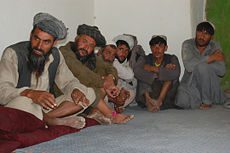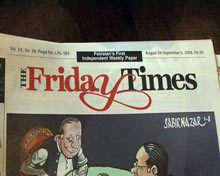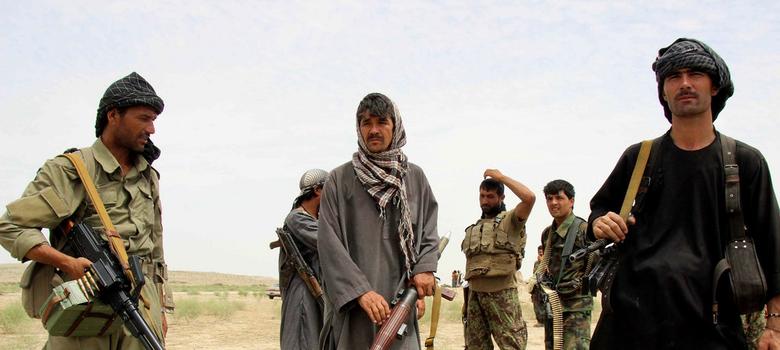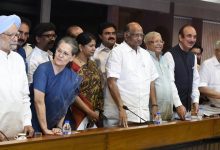The Pashtun resurgence, hyphenated from political parties, is the expression of a new identity politics. Anger got accumulated out of individual and collective experiences of Pashtuns in the distinct socio-political milieu of the post-9/11 realities. Here’s a report for Different Truths.
“Naqeeb Masud Shaheed: Zwanan Mo Qatal Kege Da Sanga Azadi Da, Pashto Der Khkule Nazam” – a pick from a song in Pashto by Pashtuns has been reverberating in the wide space confronting of the National Press Club, Islamabad, where thousands of Pashtuns began a sit-in protest more than a week ago. A poster near the dais in English, Urdu, and Pashto read ‘Justice for Naqeeb Masud’. Twenty-seven-year-old Naqeebullah Mehsud (also known as Naseemullah), employed at a garment mill in Karachi, was a victim of extrajudicial killing in January and an official probe proved that the young man, hailing from Waziristan, was innocent and falsely accused of having been a Taliban activist. An aspiring male model, Naqeeb ran a Facebook page that became popular for pictures of himself, posted modelling clothes and hairstyles. The earning therefrom helped him fund his modeling endeavour.
On 13 January he was charged with militancy and links with Jashkar-e-Jhangvi and the Islamic state of Syria and Iraq. Naqeeb’s family and relatives shot back, challenging the accusation that convinced the government of Sindh province to set up an inquiry commission to investigate the police encounter. The probe concluded that Naqeeb was innocent and killed in a fake police encounter. Pakistan’s Supreme Court took suo-moto action of the incident. The police officer Rao Anwar, who led the extra-judicial killing, slipped into underground immediately thereafter. He was last seen on 23 January at the Islamabad airport trying in vain to flee the country on a Dubai-bound flight. The bid was foiled by immigration officials. The concerned anti-terrorism judge directed the investigation officer to arrest and produce him by 16 February.
All this triggered a massive retaliation – a spontaneously organised a long march, based on four demands: Justice for Naqeeb Masud, total cessation of Pashtun genocide in Pakistan, including total stop to human rights violations in Federally Administered Tribal Area (FATA) and Islamabad, withdrawal of civil and military administration from FATA and installation of a United Nations-led administration. The indignation against the ongoing slow-motion Pashtun genocide in Pakistan, human rights violations in FATA and state-sponsored terrorism and militarism are deepening and widening. A long match, dominated by youths, kickstarted at Derra Ismail Khan of Khyber-Pakhtunkhwa on 26 January. Marchers passed through Lakki Marwat, Bannu, Kohat, Peshawar, Charsadda, Mardan and Sawabi districts of Khyber Pakhtunkhwa, where a large number of Pashtuns joined the marchers. Finally, it entered Islamabad and began the sit-in demonstration. There were more than 10,000 Pashtuns from Khyber Pakhtunkhwa and Balochistan.
 The protest movement visibly unnerved the establishment, the military power-mongers in the main. Which is why the dominant media blacked out the event initially (under diktat from the ruling brass), wide coverage by international media like New York Times, Independent of London and Le Monde notwithstanding. Lashed out at the nexus between power-that-be in Islamabad and the Fourth Estate-in-bondage, Pashtun nationalist Bushra Gohar and a top leader of Awami National party and a former member Pakistan’s National parliament Tweeted “Blackout by media of today’s huge gathering of Pashtuns in front of Press Club in Islamabad, demanding justice for Naqeeb and end to state atrocities in FATA, has proved beyond doubt, freedom of media in Pakistan is a myth, a lie.”. A Pashtun/Afghan leader warned Pakistan, especially the Punjabi elite and, ISI. “We have fought for 40 years; we know how to defeat Punjabi elite. You only need to start the fight. Let the rest be up to us. Lar aw bar Pukhtana”.
The protest movement visibly unnerved the establishment, the military power-mongers in the main. Which is why the dominant media blacked out the event initially (under diktat from the ruling brass), wide coverage by international media like New York Times, Independent of London and Le Monde notwithstanding. Lashed out at the nexus between power-that-be in Islamabad and the Fourth Estate-in-bondage, Pashtun nationalist Bushra Gohar and a top leader of Awami National party and a former member Pakistan’s National parliament Tweeted “Blackout by media of today’s huge gathering of Pashtuns in front of Press Club in Islamabad, demanding justice for Naqeeb and end to state atrocities in FATA, has proved beyond doubt, freedom of media in Pakistan is a myth, a lie.”. A Pashtun/Afghan leader warned Pakistan, especially the Punjabi elite and, ISI. “We have fought for 40 years; we know how to defeat Punjabi elite. You only need to start the fight. Let the rest be up to us. Lar aw bar Pukhtana”.
Protesters kept chanting slogans that Pakistan’s security agencies have been harbouring, sheltering and conducting terrorism in FATA and Afghanistan, aimed at de-Pashtunisation and undermining the US-led war on terror. The Pashtun assertion marks the emergence of a new pattern of politics of resistance that came to a head after protracted resentment for over a decade in the Pashtun region. The song repeatedly chants ‘inqilabi’. For the military-feudal establishment, itself rattled by sporadic and unpredictable hits from terrorists, the Pashtun retaliation is a mini-political quake.
The only political party that unhesitatingly sided with the protesters is the ANP. Addressing the sit-in demonstration Gohar demanded immediate arrest of the police officer. The head of Pakhtunkhwa Wolesi Tahreek Dr. Said Alam Mahsood hailed the historic Pashtun procession in Islamabad “Our sit-in will continue until we find justice for Naqeeb and favourable solutions to other problems of Pashtuns, posed by the state of Pakistan.” Another young leader Abdul Hai Wazir termed the military establishment of Pakistan as the national enemy of Pashtuns and urged the Pashtuns in FATA and Pakistan to firmly stand against the state-sponsored terrorism in Pakistan, resulting in Pashtun genocide and human rights violations. “Pashtun genocide in Pakistan will continue, as long as Pashtuns do not firmly stand to confront the disputed state of Pakistan”.
Encounter killings, mostly fake, are common in Pakistan, especially in FATA and other tribal-infested regions. Civil rights groups snap fingers at police for inability to produce convincing evidence for a judicial conviction and resorting to extrajudicial killings of suspects. In 2016 alone, at least 318 suspects were gunned down through raids and shootouts in Karachi, according to the Human Rights Commission of Pakistan, an independent rights organisation.
The Pashtun resurgence, hyphenated from political parties, is the expression of a new identity politics. Anger got accumulated out of individual and collective experiences of Pashtuns in the distinct socio-political milieu of the post-9/11 realities. Pashtuns were left with no alternative save standing on their own feet in strong protest against individual humiliation, displacement, unlawful abductions and detentions,  ethnic profiling and stereotyping, and lost dear ones in military operations, terrorist violence, and drone attacks over a decade and a half. The tormenting personal and collective experiences of them were made worse by the indifference of mainland Pakistan towards their plight and increasing marginalisation. Almost the whole of Pashtun society is traumatised by terrorism that virtually imposed its politics of fear and discrimination. The victims are Pashtun labourers, students, and salaried class.
ethnic profiling and stereotyping, and lost dear ones in military operations, terrorist violence, and drone attacks over a decade and a half. The tormenting personal and collective experiences of them were made worse by the indifference of mainland Pakistan towards their plight and increasing marginalisation. Almost the whole of Pashtun society is traumatised by terrorism that virtually imposed its politics of fear and discrimination. The victims are Pashtun labourers, students, and salaried class.
Nazam Sethi, in a signed editorial of the current issue of The Friday Times (Lahore), states with a biting sarcasm, “his is an opportune moment to raise a bigger but urgently needed demand – that of the merger of FATA with mainstream Khyber-Pakhtunkhwa province so that the “tribal areas” are also brought into the fold of the general “democratization” and “civilianization” of state and society under way in Pakistan, with all its imperfect paraphernalia of elections, rule of law, accountability, local government, etc. Every government in the last twenty years has promised to amend the constitution and bring about this reform but each has shied away at the last minute because of countervailing pressure from party political or tribal vested interests in coalition with the ruling party”.
Sankar Ray
©IPA Service
Photos from the Internet
#Pakistan #Democratization #Civilianization #LocalGovernment #Protester #PashtunResurgence #Islamabad #IPA #DifferentTruths





 By
By

